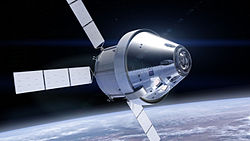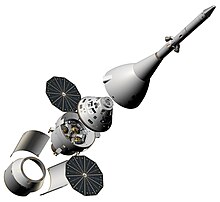This article is about NASA's crew vehicle. For other spacecraft and rockets called Orion, see
Orion in astronautics.
Orion
 |
| Description |
| Role: |
Beyond LEO spacecraft.[1] |
| Crew: |
0–4[2] |
| Launch vehicle: |
Space Launch System,
Delta IV (Exploration Flight Test 1),
Ares I (cancelled)
|
| Launch date: |
5 December 2014 (unmanned test launch)[3][4][5][6] |
| Dimensions |
| Height: |
Approximately 3.3 m (10.83 ft) |
| Diameter: |
5 m (16.5 ft) |
| Pressurized volume: |
19.56 m3 (691 cu ft) [7] |
| Habitable volume: |
8.95 m3 (316 cu ft) [7] |
| Capsule mass: |
8,913 kg (19,650 lb) |
| Service Module mass: |
12,337 kg (27,198 lb) |
| Total mass: |
21,250 kg (46,848 lb) |
| Service module propellant mass: |
7,907 kg (17,433 lb) |
| Performance |
| Total delta-v: |
~1340 m/s (4,390 ft/s) [2] |
| Endurance: |
21.1 days[8] |
The Orion Multi-Purpose Crew Vehicle (MPCV) is a spacecraft intended to carry a crew of up to four[2] astronauts to destinations beyond-low Earth orbit (LEO). Currently under development by NASA[9] for launch on the Space Launch System,[10] Orion will facilitate human exploration of the Moon, asteroids, and Mars.
The MPCV was announced by NASA on May 24, 2011.[11] Its design is based on the Orion Crew Exploration Vehicle from the cancelled Constellation program.[12] It has two main modules. The Orion command module is being built by Lockheed Martin at the Michoud Assembly Facility in New Orleans, Louisiana.[13] The Orion service module, provided by the European Space Agency,[14][15] is being built by Airbus Defence and Space.
The MPCV's debut unmanned test flight, known as Exploration Flight Test 1 (EFT-1), was launched aboard a Delta IV Heavy rocket on December 5, 2014 on a flight lasting 4 hours and 24 minutes, landing at its target in the Pacific Ocean at 10:29 Central[3][4][16][17] (delayed from the previous day due to technical problems[18]). The first manned mission is not expected to take place until 2021 at the earliest.[19]
|
|
Text-To-Speech of this article.
|
| Problems playing this file? See media help. |
History[edit]
Orion Crew Exploration Vehicle (CEV)[edit]

Orion CEV design as of 2009.
On January 14, 2004, U.S. President George W. Bush announced the Crew Exploration Vehicle (CEV) as part of the Vision for Space Exploration.[20] The CEV was partly a reaction to the Space Shuttle Columbia accident, the subsequent findings and report by the Columbia Accident Investigation Board (CAIB), and the White House's review of the American space program. The CEV effectively replaced the conceptual Orbital Space Plane (OSP), which itself was proposed after the cancellation of the Lockheed Martin X-33 program to produce a replacement for the space shuttle. As the Vision for Space Exploration was developed into the Constellation program under NASA administrator Sean O'Keefe, the Crew Exploration Vehicle was renamed the Orion Crew Exploration Vehicle, after the constellation of the same name.[21]
Constellation proposed using the Orion CEV in both crew and cargo variants to support the International Space Station and as a crew vehicle for a return to the Moon. The Apollo-like design included a service module for life support and propulsion and was originally intended to land on solid ground on the US west coast using airbags, but later changed to ocean splashdown.[22] The Orion CEV was to weigh about 25 tons (23 tonnes), less than the 33 ton (30 tonne) Apollo command/service module. The crew module would weigh about 9.8 tons (8.9 tonnes), greater than the equivalent Apollo command module at 6.4 tons (5.8 tonnes). With a diameter of 16.5 feet (5 meters) as opposed to 12.8 feet (3.9 meters), it provided 2.5 times greater volume.[23] The service module was originally planned to use liquid methane (LCH4) as its fuel, but switched to hypergolic propellants due to the infancy of oxygen/methane-powered rocket technologies and the goal of launching the Orion CEV by 2012.[24][25]
The Orion CEV design consisted of two main parts: a conical crew module (CM) and a cylindrical service module (SM) holding the spacecraft's propulsion system and expendable supplies. Both were based substantially on the Apollo command and service modules (Apollo CSM) flown between 1967 and 1975.[26]
The Orion CEV was to be launched on an Ares I rocket to low Earth orbit, where it would rendezvous with the Altair lunar surface access module (LSAM) launched on a heavy-lift Ares V launch vehicle for lunar missions.
Cancellation of Constellation program[edit]
On October 11, 2010, the Constellation program was cancelled, ending development of the Altair, Ares I, and Ares V. The Orion Crew Exploration Vehicle was renamed the Multi-Purpose Crew Vehicle (MPCV), to be launched on the Space Launch System.[27]
Orion Multi-Purpose Crew Vehicle (MPCV)[edit]
On October 30, 2014, the spacecraft completed its first Flight Readiness Review (FRR), allowing the vehicle to be integrated with the Delta IV rocket that carried it to space on the successful Exploration Flight Test 1 (EFT-1) on December 5, 2014.[28][29]
The Orion MPCV resembles its Apollo-era predecessors, but its technology and capability are more advanced. It is designed to support long-duration deep space missions, with up to 21 days active crew time plus 6 months quiescent.[30] During the quiescent period crew life support would be provided by another module such as a Deep Space Habitat. The spacecraft's life support, propulsion, thermal protection and avionics systems are designed to be upgradeable as new technologies become available.
The MPCV spacecraft includes both crew and service modules, and a spacecraft adaptor.
The MPCV's crew module is larger than Apollo's and can support more crew members for short or long-duration spaceflight missions. The service module fuels and propels the spacecraft as well as storing oxygen and water for astronauts. The service module's structure is also being designed to provide locations to mount scientific experiments and cargo.
Crew module (CM)[edit]

Test of Orion's parachute system in July 2012.
The Orion crew module (CM) is the transportation capsule that provides a habitat for the crew, provides storage for consumables and research instruments, and serves as the docking port for crew transfers. The crew module is the only part of the MPCV that returns to Earth after each mission and is a 57.5° frustum shape, similar to that of the Apollo command module. As projected, the CM will be 5.02 meters (16 ft 6 in) in diameter and 3.3 meters (10 ft 10 in) in length,[31] with a mass of about 8.5 metric tons (19,000 lb). It is to be built by the Lockheed Martin Corporation.[32] It will have more than 50% more volume than the Apollo capsule, which had an interior volume of 5.9 m3 (210 cu ft), and will carry four to six astronauts.[33] After extensive study, NASA has selected the Avcoat ablator system for the Orion crew module. Avcoat, which is composed of silica fibers with a resin in a honeycomb made of fiberglass and phenolic resin, was previously used on the Apollo missions and on select areas of the space shuttle for early flights.[34]
Orion's CM will use advanced technologies, including:
- "Glass cockpit" digital control systems derived from those of the Boeing 787 Dreamliner.[35]
- An "autodock" feature, like those of Russian Progress spacecraft and the European Automated Transfer Vehicle, with provision for the flight crew to take over in an emergency. Previous American spacecraft (Gemini, Apollo, and Space Shuttle) have all required manual piloting for docking.
- Improved waste-management facilities, with a miniature camping-style toilet and the unisex "relief tube" used on the space shuttle (whose system was based on that used on Skylab) and the International Space Station (based on the Soyuz, Salyut, and Mir systems). This eliminates the use of the much-hated plastic "Apollo bags" used by the Apollo crews.
- A nitrogen/oxygen (N
2/O
2) mixed atmosphere at either sea level (101.3 kPa or 14.69 psi) or slightly reduced (55.2 to 70.3 kPa or 8.01 to 10.20 psi) pressure.
- Much more advanced computers than on previous manned spacecraft.
The CM will be constructed of the aluminium lithium (Al/Li) alloy used on the shuttle's external tank, and on the Delta IV and Atlas V rockets. The CM itself will be covered in the same Nomex felt-like thermal protection blankets used on parts on the shuttle not subject to critical heating, such as the payload bay doors. The reusable recovery parachutes will be based on the parachutes used on both the Apollo spacecraft and the Space Shuttle Solid Rocket Boosters, and will also use the same Nomex cloth for construction. Water landings will be the exclusive means of recovery for the Orion CM.[22][36]
To allow Orion to mate with other vehicles it will be equipped with the NASA Docking System, which is somewhat similar to the APAS-95 docking mechanism used on the Shuttle fleet. The spacecraft will employ a Launch Escape System (LES) like that used in Mercury and Apollo, along with an Apollo-derived "Boost Protective Cover" (made of fiberglass), to protect the Orion CM from aerodynamic and impact stresses during the first 2 1⁄2 minutes of ascent. Its designers claim that the MPCV is designed to be 10 times safer during ascent and reentry than the Space Shuttle.[37] The CM is designed to be refurbished and reused. In addition, all of the Orion's component parts have been designed to be as generic as possible, so that between the craft's first test flight in 2014 and its projected Mars voyage in the 2030s, the spacecraft can be upgraded as new technologies become available.[38]
-
Orion ground test article in Colorado on May 13, 2011.
-
EFT-1 Orion after final weld on June 22, 2012.
-
The Orion MPCV ground test vehicle is lifted into the acoustic chamber at Lockheed Martin's facilities near Denver in preparation for the Launch Abort Vehicle Configuration Test.
-
The Orion ground test vehicle sits on a work stand in the Operations and Checkout O&C Facility at NASA's Kennedy Space Center in Florida.
-
Completed EFT-1 Orion on September 8, 2014.

